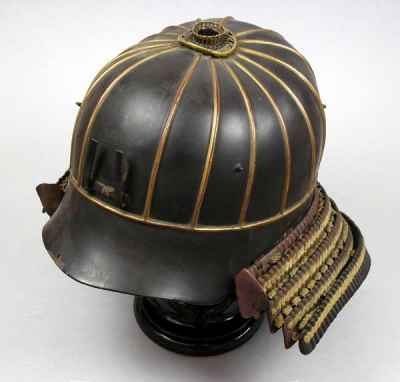Helmet (2007.31.1)
 JapanHelmet from Japan, Asia. Collector not known. Found unentered and added to the Museum's colections in 2007.
JapanHelmet from Japan, Asia. Collector not known. Found unentered and added to the Museum's colections in 2007.
This Japanese helmet (kabuto) is made from sixteen separate, riveted plates joined with ribs highlighted in gold. The lacing on the neck-guard is of an antique style and the helmet may date as far back as 1500.
Sacred Weapons
On the front of the helmet, above the peak, is a small forked metal structure, called an oharaidate. This term translates as 'August Prayer-Slip Stand', and shows that written copies of Buddhist religious texts were displayed on the front of Japanese helmets before the use of heraldic devices and ornate sculptural forms became common. This Japanese invocation of powerful Buddhist spirits, such as Bodhisattvas or 'saints', has strong parallels with the Buddhist inscriptions that also appeared on contemporary armour in Korea and Tibet. It also reflects a widespread Buddhist belief in the real spiritual power of reading the written word. This can be seen most clearly in prayer wheels, which contain Buddhist scripture; each rotation of the wheel is understood as a reading, which is heard by the deities.
The central rosette or crown-tube is known as a tehen. Historically, the construction of a hollow tube on top if the helmet is a feature acquired ultimately from the Mongols, used for drawing long hair up though the hole to wear into battle as a natural plume. The Japanese and Korean warriors of ancient times emulated this practice but even after it was abandoned, the tehen remained.
In more recent times, the tehen became known as Hachiman-Za ('the seat of Hachiman'). Hachiman is an important Japanese deity, the patron of samurai warriors and the god of worldly prosperity and war. He is also the leader of the Shi-Tenno (Four Guardian Gods) and so the presence of the Hachiman-Za on the helmet permitted these Buddhist gods to accompany the warrior into battle, affording him protection and success. To reinforce this aspect of samurai beliefs and military confidence, you will notice some small pointed rivets on the helmet bowl. There are four rivets, one in each corner, pointing NE, SE, SW and NW and are known as the Shi-Tenno-Byo or the 'Rivets of the Four Guardian Gods.'
A final word about Hachiman: he is closely related to Bishamon, another major Japanese god of war. When a Japanese armourer made a particularly fine piece, it was never used in battle, but was taken directly to the temple and offered directly to Hachiman or Bishamon, in order to encourage the god's assistance with the smith's future work.





